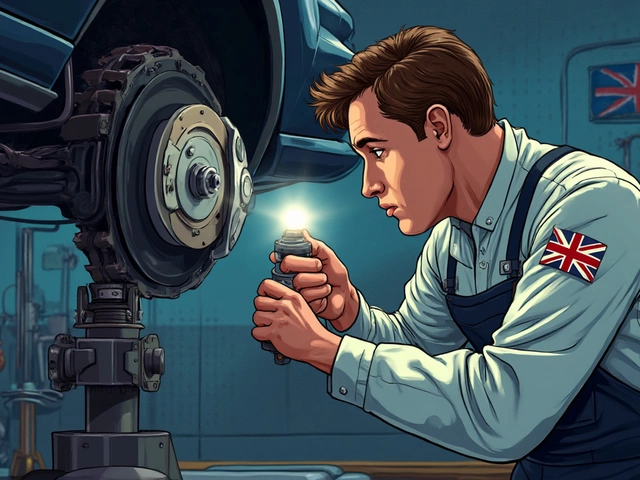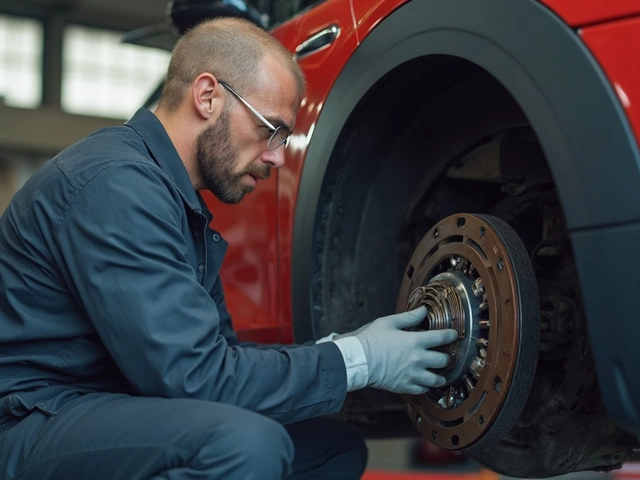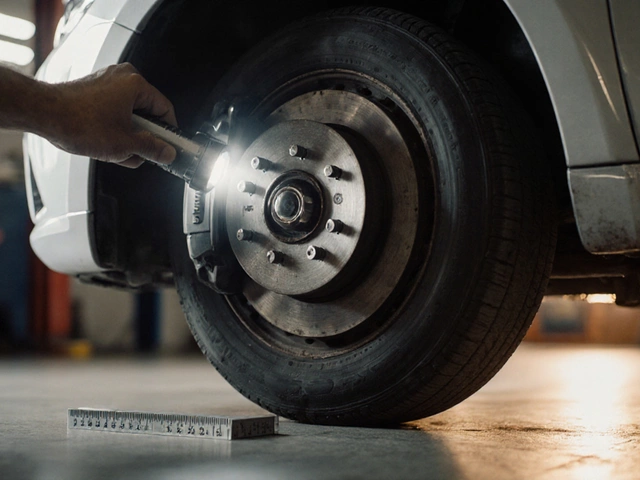Imagine flying over a pothole on the M32 and your car feels like a bouncy castle on wheels. Not fun. If your ride starts handling strangely or you're hearing weird clunks, you could be dealing with bad struts. This isn’t some obscure car problem—the struts play a front-line role in ride comfort and safety. Ignore them, and you could be looking at more than just an annoying noise or a rough ride. With the state of UK roads and all the rain we get in Bristol, your struts might be under even more pressure than you think. Bad struts aren't rare; millions of drivers replace theirs every year. Knowing the symptoms can save your tyres, your wallet, maybe even you or your passengers.
What Struts Actually Do and Why They Matter
Let’s get one thing straight: struts are more than just springs and shocks jammed under your bonnet. In most cars and some SUVs—think Ford Focus or Vauxhall Astra—the struts combine the shock absorber and coil spring in one unit, sitting on each wheel. These guys keep your tyres glued to the road, make your steering precise, and absorb every annoying rattle or jolt from potholes or speed bumps. You know that floaty or ‘squeezy’ feeling when you brake or turn? Struts stop that. If one fails, not only does your car become a handful to drive, but your braking distances shoot up and your tyres can wear unevenly—fast.
Over time—and it doesn’t matter if you drive a diesel burner or a hybrid—struts take a beating. Think about the pothole epidemic across Britain. Council data shows that, on average, there are over 1.5 million pothole-related breakdowns a year in England alone. That’s a lot of cars hammering their struts every day. Plus, our wet climate can accelerate rust, and with winter road salt, seals inside struts break down even quicker. Most experts reckon strut life hovers between 50,000 to 100,000 miles, but harsh conditions can cut that number in half. Ignore busted struts, and your car could end up failing its next MOT, or even worse, losing control in an emergency.
Want to check how your struts are doing? Pop your bonnet and take a peek at the top of the strut towers—look for oily residue or cracked rubber mounts. Or try the basic ‘bounce test’: press down firmly on a fender and let go. If your car bounces more than two times, suspect worn struts. Still, the best check is how it feels when driving. If handling changes or the car feels boat-like, don’t brush it off.

Spotting Bad Struts: Classic Symptoms You Can’t Ignore
So, what screams “bad struts” louder than your mate after a lost penalty shootout? For starters, that excessive bouncing or rolling feeling after going over a speed bump. You shouldn’t feel like you’re on a roller coaster every time you steer or stop. If your car noses forward a lot during braking or sways in corners more than usual—yep, dodgy struts could be to blame. Here’s a list of classic symptoms:
- Unusual noises: Clunking, banging, or rattling over rough roads or bumps. These noises might get worse the colder it is, since seals stiffen up.
- Excessive vehicle bounce: Your car keeps bouncing after hitting a pothole, especially at higher speeds.
- Poor steering response: Turns feel sloppy, delayed, or vague—like your front wheels are playing catch-up with your steering wheel.
- Braking dips: The nose of your car dives deeply when braking, even from moderate speed.
- Uneven tire wear: Cupping, bald spots, or strange tread patterns. If you rotate tyres and the problem keeps showing up, suspect the struts.
- Leaking hydraulic fluid: Oily patches around the strut body—means the seals are gone and their function is compromised.
- Handling instability: On the motorway, the car starts ‘floating’ or wandering, especially in strong winds or when overtaking trucks.
- Visible physical damage: Dents, broken mounts or rusty springs on the struts themselves.
It’s wild how quickly things can spiral. According to insurance industry data (like figures from RAC and AA), defective suspension is one of the top three reasons for failed MOTs in the UK. Damaged struts leave your car dragging, which can slash stopping distances in wet weather by as much as 20%. That’s metres further during an emergency stop—plenty of time to lose control or plough into the next car.
Got little ones or pets on board? Worn struts also mean your wheels don’t grip the road as they should, making it easier to lose traction in heavy rain or when swerving suddenly. Plus, every bounce is passed straight through the steering wheel and up your arms, which gets tiring fast on longer drives. If it feels like your car is fighting you instead of listening, check those struts.
| Symptom | What It Means | Potential Risk |
|---|---|---|
| Excessive Bounce | Strut can't absorb shocks | Reduced ride control, tire damage |
| Clunking/Rattling Noises | Internal damage or loose mounts | Parts could break, handling loss |
| Leaking Fluid | Seal failure, no damping | Strut complete loss of function |
| Braking Dip/Nose Dive | Lack of suspension stability | Increased stopping distances |
| Uneven Tire Wear | Improper wheel alignment, poor contact with road | Frequent tire replacements, MOT failure |
| Poor Steering Feel | Worn internal components | Dangerous in emergencies |
Shockingly, you can actually hear and feel most strut issues. If it’s been years since your last replacement, or you’re pushing high mileage, symptoms might sneak up slowly—but they get worse, never better. And don’t rely only on your car’s dash warning lights—they won’t light up for suspension problems, so you’re really the first line of defence.

Fixing Bad Struts: Practical Advice, Costs, and Tips
So you’ve nailed down a few signs pointing to bad struts—what next? Good news: you don’t need to be a mechanic to spot or deal with the basics, but when it comes to fixing them, leave it to the pros. Strut replacement is a high-pressure job, literally—those springs are compressed and can cause nasty injuries if they let go. According to the AA, the average cost to replace a pair of struts in the UK is about £250-£500, depending on your make and model. If you wait too long, you risk damaging other expensive parts like the control arms, ball joints, or even your wheel bearings. That can push costs way higher and, more importantly, risk your safety.
If you’re not sure whether you need a full replacement or just a new strut mount or bushing, a trusted garage can check. Some signs, like a bouncy front end or leaks, always mean the strut itself is done for, not just a minor part. Usually, struts are replaced in pairs—both front or both rear—since changing one can throw off your car’s balance. Check your owner’s manual for recommended replacement intervals, but don’t just go by miles. Conditions matter—if you drive the backroads around Somerset or haul kids over rough city streets every day, your timeline might be much shorter.
Want to avoid strut trouble in the first place? Try this checklist:
- Avoid slamming into potholes or mounting curbs (easy to say, much harder in Bristol, with all the never-ending roadworks).
- Keep an eye out for wet or oily marks near the wheels when washing your car.
- Listen for new noises after rough rides or extreme weather—they often signal trouble before the symptoms get critical.
- Have your alignment and suspension checked at every yearly service, or if you notice uneven tire wear or pulling to one side.
- Replace tyres and struts as a set if your car’s behaviour changes overnight—you’ll get better grip and a smoother drive.
If you’re buying a used car, always test for a smooth ride and look for strut leaks. Sellers rarely mention worn struts, and you can use evidence of bad ones to negotiate a discount. Pay special attention if the mileage is over 60,000 or the car’s mostly city-driven (those speed bumps rack up damage).
Not sure if it’s struts or something else? Confusingly, many suspension faults feel the same. For example, if your car makes a creaking noise at low speeds, especially when turning the wheel, the culprit could be strut mounts, bushings, or even a failing sway bar. But clunking and bounce usually mean struts. If in doubt, ask for a professional suspension check—some garages offer free inspections in hopes you’ll book repairs with them.
Don’t let the cost scare you off. Good struts can transform how your car feels, making it far more predictable and safe. Hold off too long, and you’re risking tire blowouts, poor control, and a failed MOT (which is its own pain if you need your car daily). So if your ride feels sketchy, your tyres look weird, or your car just isn’t behaving, odds are your struts are sending you a not-so-subtle SOS. Listen to it—and enjoy a much comfier, safer drive.






